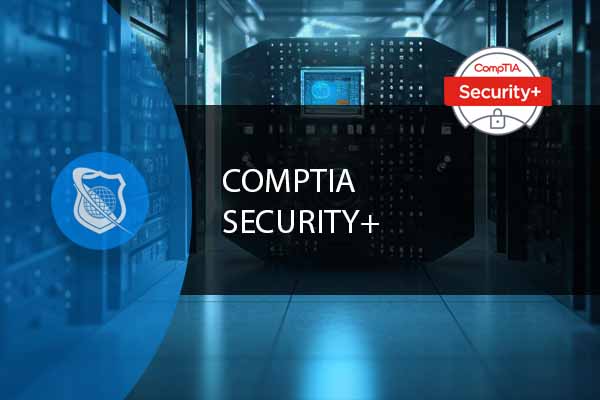Introduction
Passing the CompTIA Security+ exam is more than just another credential; it’s a gateway to a fulfilling career in the ever-evolving field of cybersecurity. This blog aims to be your ultimate Security+ study guide, providing you with all the resources, tips, and strategies you need to prepare for and pass the exam.
Section 1: Understanding the CompTIA Security+ Exam
Overview of the Certification
The CompTIA Security+ certification is a globally recognized credential that validates your foundational skills in cybersecurity. Whether you’re an aspiring IT professional or an experienced network administrator, this certification can be a critical step in your career development. This section serves as your SY0-601 study guide and security plus certification study guide, offering insights into what the exam entails.
Secure Your Networks and Prevent Password Breaches
Our robust CompTIA Sec+ course is the perfect resouce to ensure your company’s most valuable assets are safe. Up your security skills with this comprehensive course at an exceptional price.
Exam Details
- Number of Questions: Up to 85
- Types of Questions: Multiple-choice and performance-based
- Duration: 90 minutes
- Passing Score: 750 on a scale of 100-900
Section 2: How to Study for CompTIA Security+
Importance of a Study Plan
Creating a Security+ study plan is crucial for effective preparation. A well-structured plan will help you allocate time for different topics and ensure that you cover all the necessary material.
Best Resources for Study
When it comes to finding the best CompTIA Security+ study guide, you have several options. Books, often referred to as the Sec+ book or Sec + study guide, offer in-depth explanations and practice questions. Online courses provide interactive lessons and quizzes. For those looking for a comprehensive and interactive learning experience, check out our CompTIA Security+ Certification SY0-601 Course. There are also free resources available, such as the CompTIA Security+ study guide free and Security+ 601 study guide free, which can be valuable for supplementing other materials.
Section 3: Effective Study Strategies
How to Make the Most of Your Study Time
The best way to study for Security+ is to combine different types of resources. Use books for theory, online courses for interactive learning, and practice tests to gauge your readiness. This multi-faceted approach is also the best way to study for CompTIA Security+ as it ensures a well-rounded preparation. Whether you’re using a Sec+ study guide or a Sec plus study guide, make sure to practice regularly.
Importance of Practice Tests
Practice tests are an invaluable tool in your Security+ study. They simulate the actual exam environment, allowing you to assess your readiness and identify areas that need improvement. Knowing how to pass Security+ or how to pass CompTIA Security+ becomes easier when you regularly take these practice tests. For a comprehensive practice experience, our CompTIA Security+ Certification SY0-601 Course includes over 100 practice test questions, flashcards, games, and other learning materials to help you prepare effectively.
Section 4: Tips and Tricks for Exam Day
Time Management
Managing your time effectively is crucial for success in the exam. Create a time plan before starting the exam and monitor your progress throughout. This strategy will help you allocate sufficient time to each question and review your answers.
Effective Ways to Study When Taking an Online Course:
- Set Specific Goals: Before starting the course, outline what you hope to achieve. This will give you a clear direction.
- Create a Study Schedule: Consistency is key. Allocate specific times in your day or week solely for studying.
- Take Notes: While the course material is often available for review, taking notes can help reinforce what you’ve learned.
- Participate in Forums or Discussions: Engaging with instructors and peers can provide additional insights and clarify doubts.
- Practice Regularly: Use practice tests, flashcards, and other resources to regularly test your knowledge.
- Review and Revise: Periodically go back and review previous sections to ensure that you’ve retained the information.
- Stay Committed: It’s easy to lose focus in an online setting. Keep your end goals in mind and stay committed to your study plan.
Secure Your Networks and Prevent Password Breaches
Our robust CompTIA Sec+ course is the perfect resouce to ensure your company’s most valuable assets are safe. Up your security skills with this comprehensive course at an exceptional price.
Example Questions and Answers for Security+ Exam
Question 1: What is the primary purpose of a firewall?
Answer: The primary purpose of a firewall is to filter incoming and outgoing network traffic based on an organization’s predefined security policies.
Question 2: What does the acronym CIA stand for in cybersecurity?
Answer: In cybersecurity, CIA stands for Confidentiality, Integrity, and Availability.
Question 3: What is a honeypot?
Answer: A honeypot is a decoy system designed to attract and trap attackers, diverting them from legitimate targets.
Question 4: What is the difference between hashing and encryption?
Answer: Hashing is a one-way function that transforms data into a fixed-length string, while encryption is a two-way function that allows data to be converted back to its original form.
Question 5: What is social engineering?
Answer: Social engineering is the manipulation of individuals to divulge confidential information or perform actions that compromise security.
Question 6: What is a DDoS attack?
Answer: A DDoS (Distributed Denial of Service) attack is an attempt to overwhelm a system, service, or network with excessive traffic, rendering it unavailable.
Question 7: What is the purpose of an IDS?
Answer: The purpose of an Intrusion Detection System (IDS) is to monitor network traffic for suspicious activities and alert administrators.
Question 8: What is multi-factor authentication?
Answer: Multi-factor authentication involves using two or more verification methods—something you know, something you have, or something you are—to gain access to a system.
Question 9: What is a VPN?
Answer: A Virtual Private Network (VPN) is a technology that creates a secure, encrypted tunnel over the internet between a device and a network.
Question 10: What is the principle of least privilege?
Answer: The principle of least privilege states that users should be given the minimum levels of access necessary to perform their job functions.
Question 11: What is a zero-day vulnerability?
Answer: A zero-day vulnerability is a software flaw that is unknown to the vendor and is exploited by attackers before it can be patched.
Question 12: What is phishing?
Answer: Phishing is a type of social engineering attack where attackers impersonate a trusted entity to trick individuals into revealing sensitive information.
Question 13: What is a VLAN?
Answer: A VLAN (Virtual Local Area Network) is a logically segmented network within a physical network that allows for better control and security.
Question 14: What is data exfiltration?
Answer: Data exfiltration refers to the unauthorized copying, transfer, or retrieval of data from a system.
Question 15: What is a digital signature?
Answer: A digital signature is a cryptographic technique used to verify the authenticity of a digital document or message.
Question 16: What is a false positive in the context of IDS?
Answer: A false positive in IDS is an alert that incorrectly indicates malicious activity when none actually exists.
Question 17: What is the main function of a proxy server?
Answer: The main function of a proxy server is to act as an intermediary between a client and a server, forwarding requests and responses.
Question 18: What is a rootkit?
Answer: A rootkit is a type of malicious software designed to gain unauthorized access to a computer and remain hidden.
Question 19: What is an incident response plan?
Answer: An incident response plan is a set of guidelines to follow when a cybersecurity incident occurs.
Question 20: What is the difference between a worm and a virus?
Answer: A worm is a standalone malware program that replicates itself to spread, while a virus attaches itself to a program or file to spread.
Question 21: What is a security policy?
Answer: A security policy is a set of rules and guidelines that govern an organization’s approach to information security.
Question 22: What is a risk assessment?
Answer: A risk assessment is the process of identifying, evaluating, and prioritizing risks to organizational assets.
Question 23: What is encryption key management?
Answer: Encryption key management involves the administration and maintenance of cryptographic keys used for encryption and decryption.
Question 24: What is a security audit?
Answer: A security audit is a systematic evaluation of an organization’s information systems to assess the effectiveness of security controls.
Question 25: What is endpoint security?
Answer: Endpoint security involves securing individual devices like computers and smartphones that connect to a network.
Question 26: You are about to initiate a penetration test. You want first to gather the email IDs of the employees. Which of the following tool should you use?
To gather email IDs of employees for a penetration test, you should utilize a reliable tool called theHarvester. This open-source tool specializes in extracting various information, including emails, employee details, sub-domains, and hostnames. By utilizing theHarvester, you can employ different search engines like Google, Bing, as well as platforms like LinkedIn, to efficiently collect the required email IDs of employees. Therefore, the appropriate tool for this task is theHarvester.
Question 27: Which protocol should be used to secure voice and video?
To secure voice and video transmissions, the recommended protocol to use is SRTP, which stands for Secure Real-time Transport Protocol. SRTP is specifically designed to ensure the confidentiality, integrity, and authenticity of real-time voice and video data. Its main purpose is to protect sensitive information communicated through voice and video channels from unauthorized access or tampering. SRTP is widely used in various applications where secure voice and video communications are crucial, providing a reliable and robust solution for protecting these types of data transmissions.
Question 28: What does NIC teaming provide along with redundancy?
NIC teaming provides both redundancy and load balancing. In addition to ensuring that network connectivity remains uninterrupted by linking multiple network interface cards (NICs) together, NIC teaming also distributes incoming network traffic across these NICs. This load balancing mechanism helps to optimize network performance and prevent any single NIC from becoming overwhelmed with traffic.
Question 29: What is the definition of False Rejection Rate (FRR)?
False Rejection Rate (FRR) is a metric used in biometric systems to evaluate the performance of authentication processes. FRR measures the percentage of times when a legitimate user is wrongly denied access or fails to be authenticated by the system.
In other words, FRR occurs when the system incorrectly rejects or denies access to genuine users. This can happen due to various reasons such as technical issues, imperfect algorithms, or the user’s biometric characteristics not matching the stored template accurately.
It is important to minimize the False Rejection Rate in biometric systems as a high FRR can result in frustration and inconvenience for legitimate users who are denied access, leading to a poor user experience. Consequently, system administrators and developers aim to strike a balance between security and usability by setting an optimal threshold for the FRR.
To evaluate the overall performance of a biometric system, FRR is often compared with the False Acceptance Rate (FAR). FAR measures the percentage of times when an illegitimate or unauthorized user is incorrectly granted access or authenticated successfully. By analyzing the relationship between FRR and FAR, the crossover error rate (CRR) can be determined, which represents the point where FRR and FAR are equal.
However, it is important to note that FRR and FAR are not the only factors to consider when evaluating the effectiveness of a biometric system. Other metrics, such as accuracy, reliability, and usability, should also be taken into account to ensure the system meets the desired performance standards.
Question 30: What is the biggest challenge in code reuse?
The biggest challenge in code reuse is the careful planning and development time required. When code is to be reused in future applications, it needs to be meticulously designed and implemented to ensure its effectiveness.
One possible misconception is that code reuse is difficult to test (Option A). However, during the initial development of the code, it undergoes thorough testing. When reused, it primarily requires testing for integration rather than individual functionality.
Another incorrect choice is that code reuse introduces more bugs (Option C). In reality, code that is intended for reuse is already tested and proven to be reliable. Therefore, it typically has fewer bugs or even none when compared to newly developed code.
Similarly, code reuse is often not difficult to integrate (Option D). Since code is developed with its reusability in mind, the integration process is usually streamlined and purposefully designed to facilitate reuse.
In summary, the most significant challenge in code reuse is the additional time and effort required for careful planning and development.
Question 31: Which environment should you use for integration testing and measuring application performance?
For integration testing and measuring application performance, it is recommended to utilize the testing environment, which is separate and isolated from the development environment. This dedicated testing environment allows you to conduct comprehensive integration testing of the different components you have developed, ensuring they seamlessly work together. Additionally, this environment provides an ideal space for accurately evaluating the performance of your application.
Question 32: Which type of attack reverses a cryptography hash function?
A type of attack that reverses a cryptographic hash function, thus revealing the original password, is known as a rainbow table attack. This attack utilizes a specially prepared table called a rainbow table, which stores precomputed hashes for various passwords. When an attacker gains access to the password hashes from a target system, they can compare these hashes with the entries in the rainbow table to retrieve the corresponding original passwords. The attacker does not need to go through the process of trying different passwords, but rather relies on the precomputed hashes stored in the rainbow table. This way, the rainbow table attack exploits the weakness of the hash function, making it possible to reverse-engineer the original password.
Question 33: What can be the carrier for a backdoor trojan into a system?
A backdoor trojan can be delivered into a system through various means. One possible carrier for a backdoor trojan is a fileless malware, which does not rely on the presence of a specific file or executable but rather exploits system vulnerabilities directly. Another carrier could be a worm, a self-replicating malware that can spread across networks and systems, potentially acting as a vehicle for a backdoor trojan. Additionally, a trojan horse can also serve as a carrier for a backdoor trojan. This type of malware is disguised as a legitimate or desirable file or program, tricking users into unknowingly installing it and granting unauthorized access to the attacker. It is important to note that a logic bomb, a form of malware that activates under specific conditions or triggers, may not typically act as a carrier for a backdoor trojan, as its primary function is to cause harm or disruption rather than provide unauthorized access to a system.
Question 34: Which type of social engineering attack has occurred if someone creates a Facebook page with your name and contains your information and photos?
In this case, the social engineering attack that has occurred is a form of identity theft. The attacker has created a Facebook page using your name and has included your personal information and photos without your knowledge or consent. This malicious act involves the unauthorized use of someone else’s identity with the intention to deceive or harm others.
Question 35: What type of attack has occurred if you were taken to a website after misspelling its name and your system becomes unstable?
If you were taken to a different website after misspelling the name of the website you intended to visit and your system becomes unstable afterwards, it is likely that a typosquatting attack has occurred.
Typosquatting is a type of attack where cyber attackers register intentionally misspelled domain names that are similar to popular and legitimate domain names. For example, they may register a domain name such as gogle.com or gooogle.com instead of Google.com. By doing so, they create malicious websites that mimic the legitimate ones.
When you accidentally visit a typosquatting website, it can lead to various malicious activities that may compromise the security of your system. These attacks can include infecting your device with malware, stealing personal information, or redirecting you to phishing websites that attempt to trick you into revealing sensitive data.
Therefore, in the scenario described, the instability experienced by your system suggests that you were most likely a victim of a typosquatting attack. It is important to be cautious when typing website addresses and to verify the domain name before entering any sensitive information or downloading any files.
Question 36: You are about to initiate a penetration test. Instead of using theHarvester tool, you want to use an alternative to enumerate subdomains. Which of the following tools can serve as an alternative to theHarvester?
When initiating a penetration test and looking for an alternative tool to enumerate subdomains instead of theHarvester, a suitable option is sublist3r.
Explanation:
Option A: Cuckoo is an open-source sandbox primarily used for malware analysis. It is not intended for subdomain enumeration and would not serve as a replacement for theHarvester.
Option B: Metasploit is a widely used penetration testing framework that provides a range of functionalities for exploits and vulnerability testing. While it is a powerful tool, it does not specialize in subdomain enumeration and would not be a direct alternative to theHarvester.
Option C: sn1per is an information gathering and penetration testing platform specifically designed for discovering attack surfaces and managing risks. Though it is a useful tool for reconnaissance, it is not primarily built for subdomain enumeration and would not be a direct alternative to theHarvester.
Option D: The correct answer is D. sublist3r is a tool specifically created for subdomain enumeration and can effectively serve as an alternative to theHarvester. It is designed to discover subdomains through various sources, providing an extensive enumeration capability in penetration testing scenarios.
By utilizing sublist3r as a substitute for theHarvester, one can effectively enumerate subdomains during a penetration test, expanding the scope of the assessment and potentially identifying additional targets of interest.
Conclusion
This blog has aimed to be your comprehensive guide for preparing for the CompTIA Security+ exam. From understanding the exam format to choosing the best study guide for Security+ and the best Security+ 601 study guide, we’ve covered all the bases. If you’re looking for the best security plus study guide, you’ve come to the right place. Remember, the journey to becoming certified is not just about passing an exam; it’s about building a strong foundation for your career in cybersecurity.
Secure Your Networks and Prevent Password Breaches
Our robust CompTIA Sec+ course is the perfect resouce to ensure your company’s most valuable assets are safe. Up your security skills with this comprehensive course at an exceptional price.
Frequently Asked Questions About CompTIA Security Plus Practice Test
What is the CompTIA Security Plus Practice Test, and how can it help me prepare for the exam?
The CompTIA Security Plus Practice Test is a set of simulated exam questions designed to mimic the actual CompTIA Security+ exam. It helps you familiarize yourself with the exam format, identify areas for improvement, and build confidence. Regular practice with these tests can significantly enhance your preparation.
Where can I find reliable CompTIA Security Plus Practice Test materials?
You can find CompTIA Security Plus Practice Test materials through various reputable sources, including ITU Online’s CompTIA Security+ Certification Training program. They offer practice questions crafted to reflect the actual exam, providing valuable insights into your readiness.
How often should I take the CompTIA Security Plus Practice Test during my study preparation?
It’s advisable to take the CompTIA Security Plus Practice Test regularly throughout your preparation. Starting early allows you to gauge your initial understanding, and repeated practice helps you track your progress and adapt your study plan as needed.
Can the CompTIA Security Plus Practice Test alone guarantee success in the CompTIA Security+ exam?
While the CompTIA Security Plus Practice Test is an invaluable tool, it should be part of a comprehensive study plan that includes textbooks, online courses, and other resources. Combining various study materials ensures a well-rounded understanding of the subject matter.
How does ITU Online’s training program complement the CompTIA Security Plus Practice Test in preparing for the exam?
ITU Online’s training program offers a comprehensive approach to CompTIA Security+ preparation, including 16 training hours, 15 on-demand videos, and 146 prep questions for a practice exam. Coupled with the CompTIA Security Plus Practice Test, it provides a structured and effective learning experience, covering all exam objectives.

























